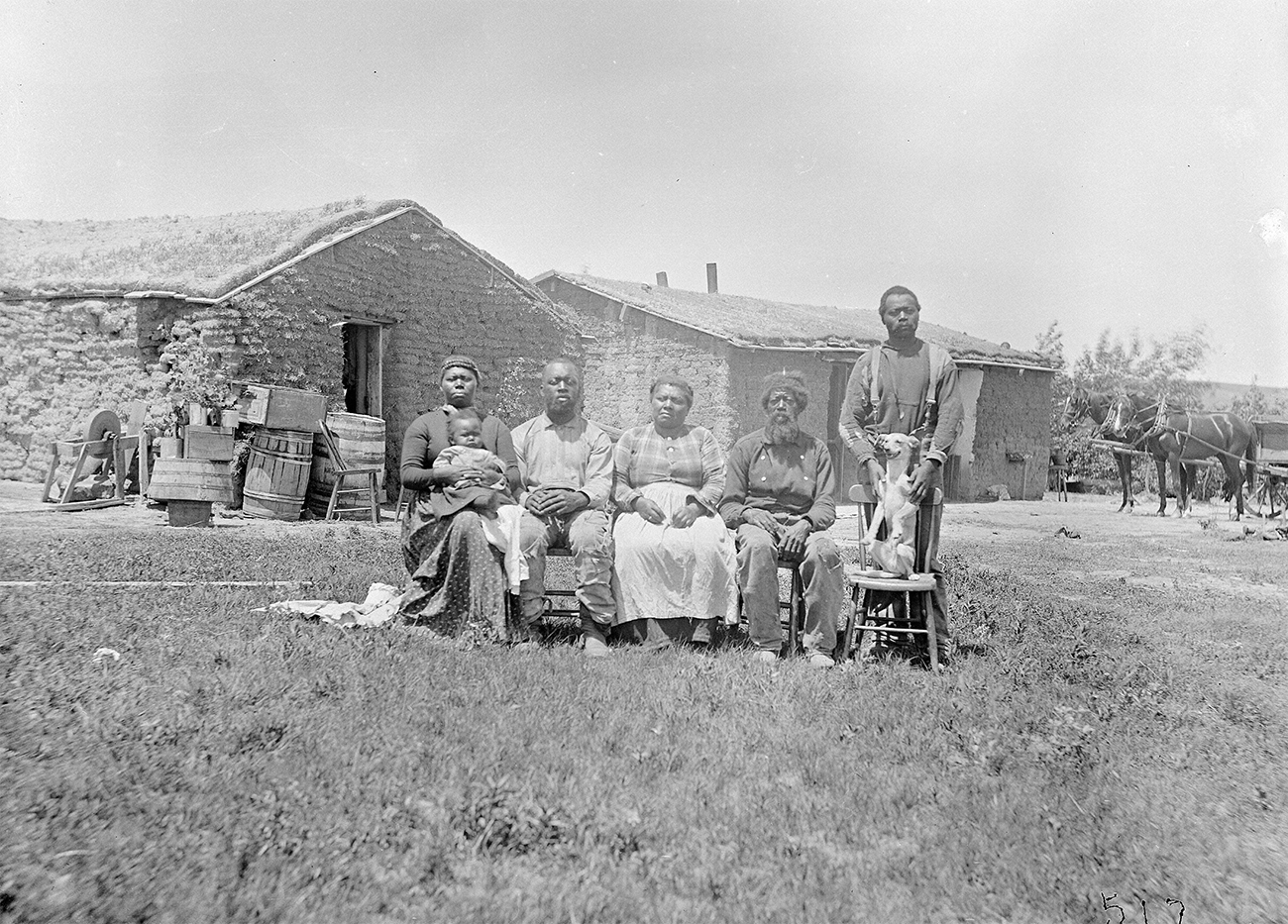
Nebraska
Reconstruction Vignette
This 1887 photo shows the Shores family posed in front of their sod house in Nebraska. Jerry, seated second from the right, was enslaved just decades prior. According to the Nebraska State Historical Society, the younger family members became noted musicians. The Shores were among many African Americans who left the South in the 1870s and 1880s, moving to the Great Plains in search of land to call their own. To the extent that land was available, however, it was only because of policies that had recently, and often in violation of federal treaties, forcibly removed Native people from the area.
Source: Library of Congress
Nebraska
Standards Overview
Coverage of Reconstruction: Nonexistent
ZEP Standards Rubric Score: 0 out of 10
The coverage of Reconstruction in Nebraska’s standards is effectively nonexistent. The Nebraska State Board of Education adopted the current social studies standards in 2019. Nebraska is a local-control state, so the state-level standards are very broad. According to these standards, Reconstruction is taught in grade 8.
The grade 8 standards mention Reconstruction several times but largely in connection to broad political topics. It is one of the possible examples given for students to use to “Evaluate the impact of people, events, and ideas, including various cultures and ethnic groups, on the United States.”
Two grade 8 standards give the Reconstruction Amendments as examples:
“Analyze the structure and roles of the United States government in meeting the needs of the citizens governed, managing conflict, and establishing order and security.”
“Compare and interpret evidence from multiple perspectives and sources to better understand the complexities of U.S. history.”
The Reconstruction Amendments are also mentioned in the high school civics course under a standard that says students will “Evaluate the structure of American constitutional government.”
Because Nebraska’s standards provide so little information about whether and how districts and schools should teach Reconstruction, we chose to investigate curricula at the district level. The Local Snapshot below is not meant as a judgment of the district’s approach to Reconstruction. It was chosen largely at random and is not factored into the grade the state standards receive. The brief analysis of district-level curricula that follows is intended to simply provide a snapshot into how state standards, or lack thereof, can shape Reconstruction pedagogy in the classroom.
Local Snapshot
Reconstruction is a stand-alone three-week unit in the grade 8 social studies course in Omaha. The unit is framed around the concept that “the future looked bleak to many southerners… Black or white” at the end of the Civil War. The unit focuses mainly on the political narrative of the era, including Black participation in politics and the Reconstruction Amendments. It also mentions the Freedmen’s Bureau and KKK. Notably, the curriculum engages with questions of land and labor, asking students “How did the system of Sharecropping limit the new freedoms of emancipated slaves in the South?”
Educator Experiences
One respondent to our survey expressed that “the varying perspectives and narratives, combined with civil unrest and polarized ideologies with punitive agendas targeting educators, make it difficult to have honest conversations” around Reconstruction. Another teacher noted that there are currently no formal restrictions on teaching Reconstruction, but “a fear of CRT by many in leadership positions” may change that.
Assessment
Nebraska covers Reconstruction extremely briefly in its social studies standards. The standards reference the Reconstruction Amendments twice and specify that the topic should be covered in grade 8, but offer no other guidance on how districts should address it in their curricula. Additionally, the standards’ framing of the Reconstruction Amendments around the “roles of the United States government” and “establishing order and security” encourage a top-down view of progress that erases the critical roles of ordinary people.
Without guidance around key Reconstruction-era history, many students will not learn about the intensification of white supremacy, the Black Codes, the KKK, debates over who would control land and labor, and Black agency and political organizing. Teaching Reconstruction effectively requires centering Black people’s struggles to redefine freedom and equality and gain control of their own land and labor during and after the Civil War. Any discussion of Reconstruction must also grapple with the role of white supremacist terrorism in the defeat of Reconstruction and the negative and positive legacies of the era that persist to this day.
In 2022, Republican lawmakers introduced LB1077, a bill designed to “prohibit public schools, public postsecondary institutions, and government entities from training or teaching certain concepts relating to race and sex” and to allow the government to withhold state funds accordingly. They introduced another similar bill, and both failed to pass. Still, their introduction is troubling. Several respondents to our survey expressed concern about the possible chilling effects on classroom education that such measures can have around the country, particularly on discussions of the history and legacies of Reconstruction.